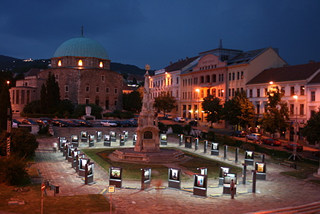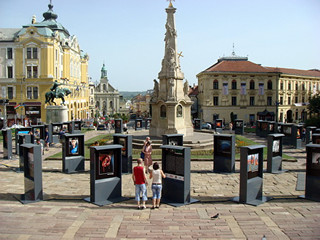 Fotografien von Jens Helmstedt waren vom 28. Mai bis 3. Juni 2008 in der ungarischen Stadt Pécs in der Open Air Fotoausstellung “100 fele Iszlam – 100 reflections of Islam” zu sehen.
Fotografien von Jens Helmstedt waren vom 28. Mai bis 3. Juni 2008 in der ungarischen Stadt Pécs in der Open Air Fotoausstellung “100 fele Iszlam – 100 reflections of Islam” zu sehen.
100 Kunstfotos internationaler Fotografen mit Motiven aus den europäischen Kulturhauptstädten im Jahr 2010 Istanbul (Türkei), Pécs (Ungarn) und Essen (Deutschland) waren vom 28. Mai bis 3. Juni 2008 auf dem Széchenyi-Platz im Zentrum von Pécs ausgestellt. Die Fotografien wurden auf einen speziellen Film gedruckt und waren in beleuchteten Schaukästen zu sehen. Das Konzept der Fotoausstellung war es, Bilder zu zeigen, die den Islam in Istanbul und in der Türkei, in Pécs mit seiner 150 jährigen osmanischen Geschichte und in Essen mit seinen muslimischen Einwanderern dokumentieren.
Exhibition concept
In 2010, Europe will have three cultural capitals: Essen in Germany, the Turkish Istanbul and the Hungarian Pecs. Between East (Istanbul) and West (Essen) Pecs is in half-way, so the call reflects also on unifying Europe and on the diversity of cultures acknowledging the power of imaginative geographies. As today the role of religion is strengthening again both in the search for identity and the political, public discourses, we would like to present these three cities by their common religious heritage.

Islam is the most dynamic world religion today. After Christianity, it is the second largest religion with 1 billion 322 million followers. Islam is so diverse that some even speak today about “Islams”, in the plural. The Muslim mode of life, system of belief and world-views are manifested in the cities: through clothing, architecture, behaviour, commerce and application of law. We would like to offer this diversity – traditions, contemporary problems and local solutions – to the audience with the help of contemporary photography.
All the three cities are influenced by the past or present of Islam while they embody by default hybrid worlds: Pecs (Pecuj) was transformed under the 150 year Ottoman rule into an Eastern, Balkan city whose architectural memoirs are respected treasures today. At the same time, famous ancient Christian casemates are to be found in Pecs and the exemplary common existence of Germans (Schwab), Hungarians, Croatians, the Roma and Serbians.
 Istanbul also unifies Christianity and the Muslim past and present because it was once Byzantium which was conquered by the Muslim Ottoman Turks in 1453. It became the capital of the Ottoman Empire, one of the most beautiful cities of Islam. Although since 1923 Turkey is a secular state, today Islam or rather the Muslim mode of life is in the forefront of heated debates. The past and present of Istanbul is symbolized by its geographical location – on the borderlines of Europe and Asia. Essen is the fifth largest city in Germany. 17 nationalities are living together in the city. Turks, Kurds, Arabs, black Africans and the refugees of war from the Balkans are represented in the largest numbers: the majority are Muslims. The economic recession lead to unusual high percentage of unemployment and to the tension between the different groups and cultures. In Essen, the present of European Islam is formed also by the economic problems.
Istanbul also unifies Christianity and the Muslim past and present because it was once Byzantium which was conquered by the Muslim Ottoman Turks in 1453. It became the capital of the Ottoman Empire, one of the most beautiful cities of Islam. Although since 1923 Turkey is a secular state, today Islam or rather the Muslim mode of life is in the forefront of heated debates. The past and present of Istanbul is symbolized by its geographical location – on the borderlines of Europe and Asia. Essen is the fifth largest city in Germany. 17 nationalities are living together in the city. Turks, Kurds, Arabs, black Africans and the refugees of war from the Balkans are represented in the largest numbers: the majority are Muslims. The economic recession lead to unusual high percentage of unemployment and to the tension between the different groups and cultures. In Essen, the present of European Islam is formed also by the economic problems.
Curators
Luca Göbölyös, Balogh Rudolf-prize winning photographer, curator of the “100 views of Transylvania” exhibition, and invited lecturer in the photography at Werk Academy. Adam Mestyan, historian and Arabist, instructor in Arabic at the Central European University (CEU) and invited lecturer in the history of Islam at ELTE University.